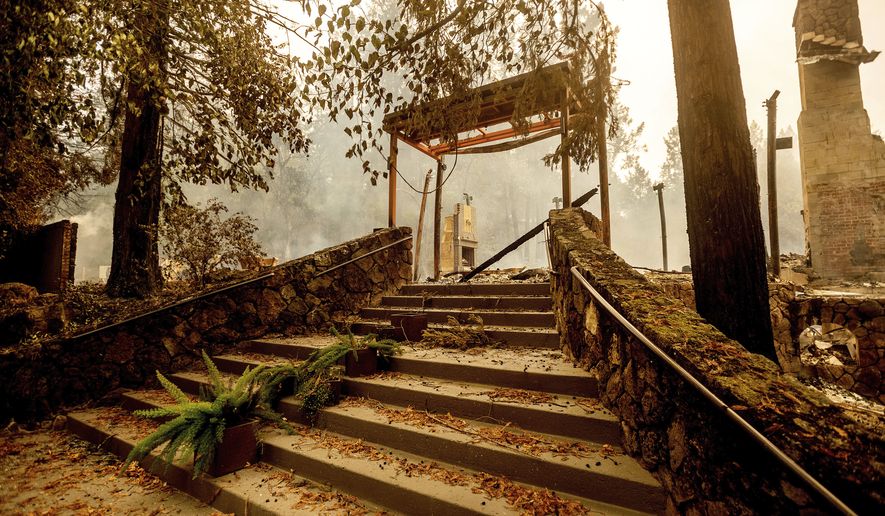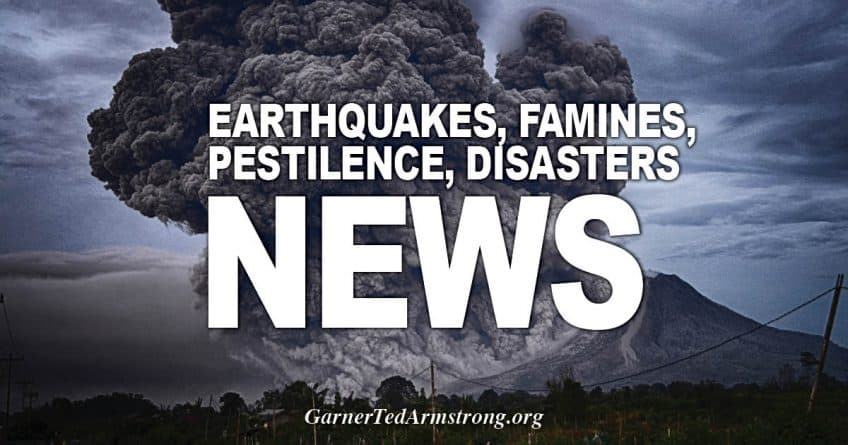
Photo by: Noah Berger
FILE – In this Sept. 28, 2020, file photo, a staircase remains at the Restaurant at Meadowood, which burned in the Glass Fire, in St. Helena, Calif. Harvest season in Northern California’s wine country draws millions of visitors each year. But harvest season now overlaps with fire season as wildfires, too, have become a yearly reality in the region. In three of the past four years, major wildfires driven by changing climate have devastated parts of the world-class region, leaving little doubt that it’s vulnerable to smoke, flames, and blackouts during the fall. (AP Photo/Noah Berger, File)
It’s not just the landscape getting scorched from record wildfires raging along the West Coast and elsewhere. The fires are having a massive economic impact as well.
Researchers project economic losses as high as $150 billion. The fires already have displaced thousands of people and destroyed millions of acres of land.
Using wildfire data and artificial intelligence resources, Zesty.ai researchers estimate that $5.9 billion to $9.8 billion has been lost as of Sept. 18.
Other data suggests this year’s wildfire season is on track to cause about $25 billion in damage. That estimate is similar to the damage two years ago when wildfires burned about 8.7 million acres nationwide, according to a report from the National Oceanic and Atmospheric Administration.
Some private reports suggest a much higher number. AccuWeather estimates that the total economic loss from wildfires now ranges from $130 billion to $150 billion.
“It’s higher than other estimates because most of those are for insured losses only,” said AccuWeather meteorologist Dave Samuel. “We take into account things like long-term business and health for people, the long-term damage the fires can cause and other things like important papers, memorabilia, photos, antiques and other priceless items that someone could lose who is not insured. So that’s basically the main difference.”
As of Monday, 49,149 fires have burned more than 8.7 million acres across the U.S. this year, the National Interagency Fire Center reported. Even with the summer heat subsiding, firefighters were battling 34 active wildfires in 11 states: California, Colorado, Idaho, Kentucky, Minnesota, Montana, Oregon, Utah, Washington, Wisconsin, and Wyoming. With 13 active wildfires, California has the most. Colorado follows with six.
Colorado Gov. Jared Polis, a Democrat touring devastation late last month, noted that the state’s 20 largest recorded wildfires have occurred since the turn of the century and its three largest — Cameron Peak, East Troublesome, and Pine Gulch — were this year.
“My heart goes out to all Coloradans who have had to flee their home or leave their community behind due to these fires,” Mr. Polis said during a visit to Boulder County. He said the fires have erupted in a year of “unprecedented challenges,” including the COVID-19 pandemic and an economic collapse.
Although this season has had fewer wildfires on average during a 10-year period, 2 million more acres have burned. From 2010 to 2019, the average was 51,779 wildfires and 6.7 million acres burned.
As of Oct. 7, the U.S. this year had 16 “weather disaster events,” including one wildfire, with losses surpassing $1 billion each, NOAA reported. A wildfire is generally the third most costly event, averaging about $5 billion in damage per incident, behind tropical cyclones and droughts.
When tacking on Hurricanes Isaias, Laura, and Sally, 48 tropical cyclones have caused a combined $974.9 billion in total damage, averaging $20.7 billion per event, NOAA officials said. The National Hurricane Center said Hurricane Katrina in 2005 and Hurricane Harvey in 2017 top out as the costliest tropical cyclones. Each caused $125 billion in damage.
In November 2018, the Camp Fire that broke out in Butte County, California, and destroyed the town of Paradise made U.S. history as the most destructive wildfire, costing $8.5 billion to $10.5 billion in insured losses alone.
Big losses
Last year, NOAA recorded $4.5 billion in damage when wildfires burned about 4.6 million acres. In 2017, wildfires caused about $19 billion in damage and burned more than 10 million acres, the second-highest number since 1983, when the National Interagency Fire Center began recording more accurate data.
Accuweather estimated that wildfires caused about $80 billion in total damage last year, $400 billion in 2018, and $85 billion in 2017.
Wildfires destroy more than 2,500 homes in the U.S. on average each year, said Forbes, citing the National Interagency Coordination Center’s 2019 yearly report. About 85% of wildfires in the U.S. from 2000 to 2017 were caused by human carelessness such as leaving campfires unattended and burning debris. Lightning is another leading cause of wildfires.
The wildfire season started early this year. An August lightning storm ignited many wildfires in California, which Mr. Samuel described as “ground zero” for additional wildfires. He said he expects another half-million acres to burn, adding to the 4.1 million acres in California. The forecast calls for no widespread rain in the state through November, and strong winds could make it an “ugly month” for the wildfire season, Mr. Samuel said.
He said wildfire seasons should have ended in many Western states, although the recent fire activity in Colorado was a surprise to him. The state had a widespread snowstorm in early September, but the landscape dried out and high winds triggered the rapid spread of the East Troublesome fire last month.
The state insurance departments in California and Colorado said they do not yet have estimates on insured losses from wildfires this year.
Destruction from fire, smoke, and water used to extinguish flames is covered under standard homeowners’, renters’ and business owners’ insurance policies, and under the optional comprehensive portion of a car insurance policy, the Insurance Information Institute said. Insurance policies also could also cover damage to a detached garage or shed, trees, lawns, and personal belongings, as well as additional living expenses such as hotel stays and laundry services.
Those who suffered personal or business losses from the devastating fires in August and are waiting for insurance settlements can register with the Federal Emergency Management Agency. Disaster assistance could cover uninsured losses or provide help to people who have waited more than 30 days on a homeowner’s claim. The deadline to register with FEMA is Nov. 23.
FEMA assistance could also could be used for disaster-related temporary housing and needs such as funeral costs and emergency home repairs not covered by insurance settlements. FEMA registration is available by visiting DisasterAssistance.gov or by calling 800\621-3362.
The U.S. Department of Agriculture, operating through a network of state and county agencies, has disaster assistance programs for farmers and ranchers affected by wildfires.
California has community development block grants for disaster recovery assistance. Congress may redirect funding to states to help areas rebuild.
Federal aid to California became a political football last month when the Trump administration denied a request by Gov. Gavin Newsom, a Democrat, to officially declare a major disaster in the state, freeing up money and logistical aid.
President Trump, after hearing from prominent California Republicans in Congress, reversed the decision and issued a formal disaster declaration.
If the president declares a disaster, people who lose their jobs as a result of the incident could apply for unemployment payments if they do not qualify for regular unemployment insurance benefits.
States, local governments, American Indian tribes, and certain nonprofit organizations can apply for hazard mitigation grants from FEMA. Although individual homeowners and businesses cannot apply for these grants directly, communities can apply on their behalf.
Source: https://www.washingtontimes.com/news/2020/nov/9/wildfires-damages-high-record-setting-150-billion/
[Disclaimer]








